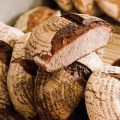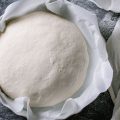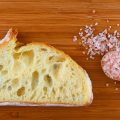Kneading is an essential step in bread baking, especially one that involves making sourdough bread. This is what makes sourdough bread especially unique, as well as the fact that it requires a sourdough starter to make the wonderful bread dough. Allowing wild yeasts and bacteria to work their magic to create an incredibly textured and tasty sourdough loaf is the ultimate intention of any sourdough bread baker. So let’s find out how long it takes to knead sourdough for future sourdough recipes!
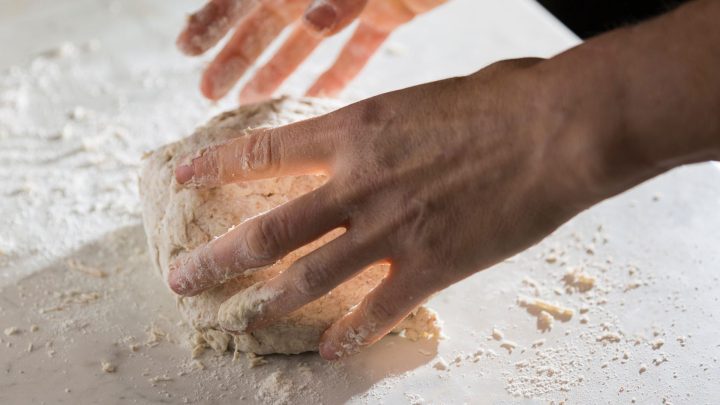
Table of Contents
- How Much Kneading Does Sourdough Bread Need?
- What Happens If You Don’t Knead Sourdough Enough?
- Can You Knead Sourdough in a Stand Mixer?
- Sourdough Kneading vs Folding
- How Do You Know When Sourdough is Kneaded Enough?
- How Long To Knead Dough After It Rises?
- No Knead Sourdough Bread Recipe
- To Knead or not to Knead Sourdough
- FAQs
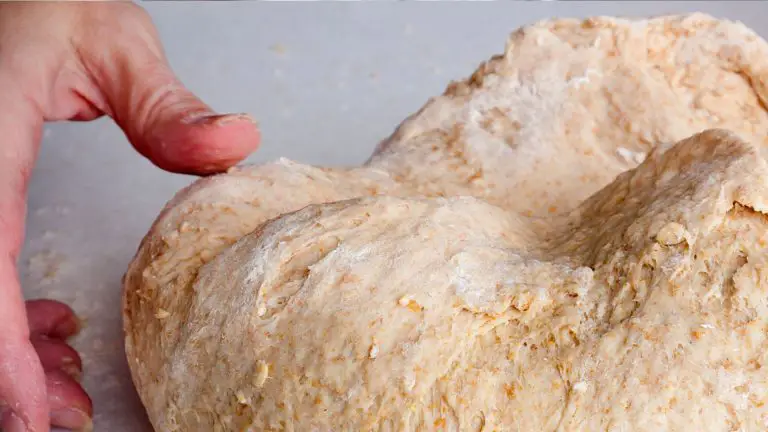
No Knead Sourdough Bread Recipe
Try this easy no-knead sourdough recipe. Combine sourdough starter with your bread-baking ingredients to create the ultimate golden-brown masterpiece.
- Total Time: 17 hrs
- Yield: 1 loaf 1x
Ingredients
- 400g bread flour
- 100g whole wheat flour
- 350g water (room temperature)
- 100g active sourdough starter (100% hydration)
- 8g salt
Instructions
- In a large mixing bowl, combine the flour and salt. Mix well.
- Add the active sourdough starter and water to the bowl. Stir until a shaggy dough forms.
- Cover the bowl with plastic wrap or a damp tea towel and let it rest at room temp for about 12 to 16 hours. This is the bulk fermentation stage.
- After the bulk fermentation, the dough should be noticeably risen and bubbly.
- Preheat your oven to 450°F (230°C). Place a Dutch oven or a lidded baking pot inside the oven while it preheats.
- Transfer the dough to a floured surface, and perform a series of stretches and folds.
- Fold the dough over itself a few times to shape it into a round loaf. Be gentle to preserve the gas bubbles.
- Place the shaped dough on parchment paper or baking sheet, and let it rest for about 30 minutes while the oven preheats.
- Carefully remove the hot Dutch oven from the oven, and place the dough seam side up, with the parchment paper, inside the pot.
- Score the top of the dough with a sharp knife or razor.
- Cover the Dutch oven with the lid and bake for 20 minutes.
- Remove the lid and continue baking for an additional 20-25 minutes or until the crust is deep golden brown. Leave the loaf in the oven for a further 10 minutes for a darker crust.
- Once done, remove the bread from the Dutch oven and let it cool on a wire rack before slicing.
- Prep Time: 16 hrs
- Cook Time: 45 mins
- Category: bread
- Cuisine: American
Nutrition
- Serving Size: 1 slice
- Calories: 250
- Fat: 5 g
- Saturated Fat: 3 g
- Carbohydrates: 33 g
- Protein: 10 g
How Much Kneading Does Sourdough Bread Need?
Sourdough bread requires a different approach to kneading compared to commercial yeasted bread.
Instead of prolonged and vigorous kneading, a gentler technique is preferred to help preserve the delicate fermentation process.
This involves a stretch and fold every 30 minutes for about 4-6 sets. This process encourages gluten development while maintaining its unique texture and flavor.
What Happens If You Don’t Knead Sourdough Enough?
Not kneading sourdough enough may compromise the gluten network, meaning that it may remain underdeveloped leading to a weaker dough structure. This can result in a dense and flat loaf with a poor oven spring. The dough may struggle to hold its shape during proofing and baking, resulting in a lack of volume and uneven crumb.
Furthermore, insufficient kneading may hinder the proper distribution of gas produced during fermentation which can lead to irregular air pockets and a less desirable texture.
Can You Knead Sourdough in a Stand Mixer?
Yes, you can knead sourdough in a stand mixer bowl.
Using a stand mixer with a dough hook attachment is a convenient and efficient way to knead sourdough, especially when handling high-hydration doughs, as they tend to have a more sticky dough.
If you wish to minimize or eliminate hand kneading altogether, then use a stand mixer for your sourdough recipes.
Why Use a Stand Mixer For Sourdough Bread?
Using a stand mixer to make sourdough bread is great for several reasons.
- Firstly, it saves time and effort, especially when dealing with larger dough batches. The mixer’s dough hook effectively kneads the dough, resulting in a quick and well-developed dough. You’ll get a smooth and more elastic dough, which can be more challenging to achieve with simple hand kneading.
- Secondly, a stand mixer provides consistent results, ensuring uniform mixing and fermentation. Hand kneading will require you to add flour, which may change the consistency of your loaf of sourdough bread.
- Finally, for bakers with limited physical abilities, or those who seek convenience, the stand mixer is an incredibly efficient tool. Though you must make sure that you monitor the dough’s progress closely.
Sourdough Kneading vs Folding
Sourdough kneading and folding are two separate techniques, actually!
Kneading involves a repetitive motion to stretch and fold the dough, develop gluten quicker, and requires careful monitoring to avoid overworking the dough.
On the other hand, folding involves gently lifting and folding the dough over itself during bulk fermentation. This method is much gentler, preserving the dough’s delicate gas structure and fermentation.
While kneading is suitable for some bakers, folding is a more favorable technique for sourdough as it aligns best with slow natural fermentation.
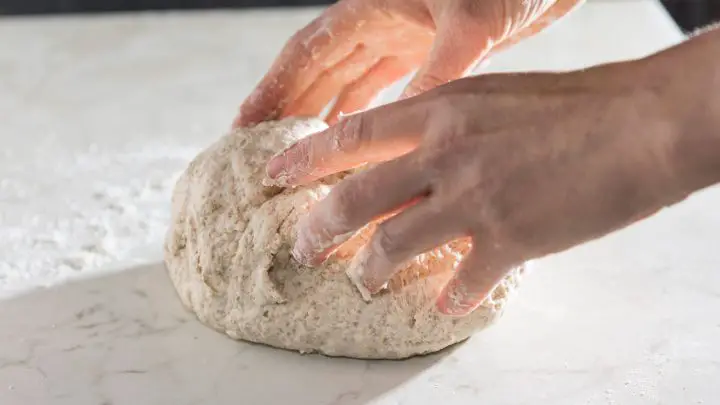
How Do You Know When Sourdough is Kneaded Enough?
Assess its texture and elasticity.
The dough should feel smooth, supple, and slightly tacky to the touch.
When pulled gently, it should stretch without tearing, forming a thin, translucent membrane, otherwise known as the windowpane test.
The well-kneaded dough will show an increase in volume, and a cohesive structure during bulk fermentation. However, over-kneading can lead to tough and overdeveloped gluten.
Can You Over Knead Sourdough?
It is certainly an unfortunate possibility!
Over-kneading can lead to too much gluten in the dough, resulting in a stiff and difficult dough to work with, causing the final loaf to be dense and tough.
Over-kneading can also risk your sourdough loaf having fewer air pockets due to the lack of gas production during fermentation.
Monitor the dough’s texture and alternate between techniques to avoid over-kneading.
How Long To Knead Dough After It Rises?
Once the dough has completed its bulk fermentation or initial rise, it does not require additional kneading. During this time, the natural fermentation process, as well as the stretch and fold technique have already helped develop enough gluten.
Kneading after the dough rises can risk flattening the dough, reducing air pockets formed during fermentation, and affecting the final texture.
Instead, you should aim to shape the dough gently into a loaf or roll. This should be done carefully in order to maintain gas structure and preserve the dough’s leavening properties before proceeding to the final proof and baking stages.
No Knead Sourdough Bread Recipe
Try this easy no-knead sourdough recipe. Combine sourdough starter with your bread-baking ingredients to create the ultimate golden-brown masterpiece. And here’s how to make it!
Ingredients
- 400g bread flour
- 100g whole wheat flour
- 350g water (room temperature)
- 100g active sourdough starter (100% hydration)
- 8g salt
Instructions
- In a large mixing bowl, combine the flour and salt. Mix well.
- Add the active sourdough starter and water to the bowl. Stir until a shaggy dough forms.
- Cover the bowl with plastic wrap or a damp tea towel and let it rest at room temp for about 12 to 16 hours. This is the bulk fermentation stage.
- After the bulk fermentation, the dough should be noticeably risen and bubbly.
- Preheat your oven to 450°F (230°C). Place a Dutch oven or a lidded baking pot inside the oven while it preheats.
- Transfer the dough to a floured surface, and perform a series of stretches and folds.
- Fold the dough over itself a few times to shape it into a round loaf. Be gentle to preserve the gas bubbles.
- Place the shaped dough on parchment paper or baking sheet, and let it rest for about 30 minutes while the oven preheats.
- Carefully remove the hot Dutch oven from the oven, and place the dough seam side up, with the parchment paper, inside the pot.
- Score the top of the dough with a sharp knife or razor.
- Cover the Dutch oven with the lid and bake for 20 minutes.
- Remove the lid and continue baking for an additional 20-25 minutes or until the crust is deep golden brown. Leave the loaf in the oven for a further 10 minutes for a darker crust.
- Once done, remove the bread from the Dutch oven and let it cool on a wire rack before slicing.
Nutrition
- Type: Bread
- Cuisine: American
- Recipe yield: 1 loaf
- Calories: 250kcal
- Preparation time: 15 minutes (12-16 hours bulk fermentation)
- Cooking time: 45 minutes
- Total time: 13-17 hours
- Calories: 250kcal
- Carbohydrates: 33g
- Protein: 10g
- Fat: 5g
- Saturated fat: 3g
To Knead or not to Knead Sourdough
Kneading sourdough is an essential step that affects the bread’s structure and texture. Finding the right balance is crucial. You must avoid overworking your dough whilst developing the gluten for a well-structured loaf.
Don’t be afraid to make mistakes. Start with a beginner sourdough recipe today!
FAQs
How Long Do You Stretch and Fold Sourdough?
Stretch and fold sourdough every 30 minutes during the first 2-3 hours of bulk fermentation. You should aim to perform 4-6 sets in total. This gentle shaping technique helps strengthen the dough’s gluten while preserving its natural fermentation, resulting in a flavorful and well-textured loaf.
Why Is My Sourdough Still Sticky After Kneading?
Sticky dough may be due to high hydration or under-kneading. High hydration doughs require gentler handing. You must ensure that you’ve kneaded dough enough to develop gluten, achieving a smoother texture. You can also adjust the quantity of flour and water to help improve the dough’s consistency.


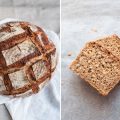
![[Video – Part 2] Entering Into Peasant Bakery 105 [video] from the seed to the peasant bakery with nicolas supiot](https://www.mydailysourdoughbread.com/wp-content/uploads/2022/11/image-16-120x120.jpeg)
